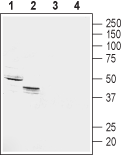Overview
- Peptide (C)RDRYNHTF(S)FEKFPME, corresponding to amino acid residues 162-177 of rat GPR4 (Accession Q4KLH9). 2nd extracellular loop.
- Rat dorsal ganglion lysate and rat and mouse kidney membranes (1:200-1:1000).
 Western blot analysis of rat dorsal root ganglion lysate:1. Anti-GPR4 (extracellular) Antibody (#AGR-041), (1:200).
Western blot analysis of rat dorsal root ganglion lysate:1. Anti-GPR4 (extracellular) Antibody (#AGR-041), (1:200).
2. Anti-GPR4 (extracellular) Antibody, preincubated with GPR4 (extracellular) Blocking Peptide (#BLP-GR041). Western blot analysis of rat (lanes 1 and 3) and mouse (lanes 2 and 4) kidney membranes:1,2. Anti-GPR4 (extracellular) Antibody (#AGR-041), (1:200).
Western blot analysis of rat (lanes 1 and 3) and mouse (lanes 2 and 4) kidney membranes:1,2. Anti-GPR4 (extracellular) Antibody (#AGR-041), (1:200).
3,4. Anti-GPR4 (extracellular) Antibody, preincubated with GPR4 (extracellular) Blocking Peptide (#BLP-GR041).
- Human THP-1 monocytic leukemia cells.
G-protein coupled receptor 4 (GPR4) belongs to a protein family comprised of 3 related G-protein coupled receptors (GPCRs): GPR4, OGR1/GPR68 and TDAG8/GPR65. Like all GPCRs, GPR4's structure is composed of seven-transmembrane-spanning domains linked by an N-terminal extracellular domain and a C-terminal intracellular domain2.
GPR4 responds to pH changes and is activated by a physiological increase in extracellular H+ through several signaling pathways including- the G12/13-protein/Rho, the Gq/PLC, and the Gs-protein/cAMP pathway1,2. It is fully activated at pH levels of 6.8 and lower and is inactive at pH levels of 7.5 and higher3,4.
Recent studies show that the pH-sensing GPCRs also have the ability to regulate cancer cell metastasis and proliferation, immune cell function, inflammation, blood vessel formation, endothelial barrier function thus making them an important therapeutic target for different diseases. Overexpression of GPR4 in human cancer cells shows involvement in driving or maintaining tumor formation.
GPR4 is expressed in several tissues including lung, vascular endothelial cells, kidney, heart, liver, skeletal muscle, ovary, and placenta.
